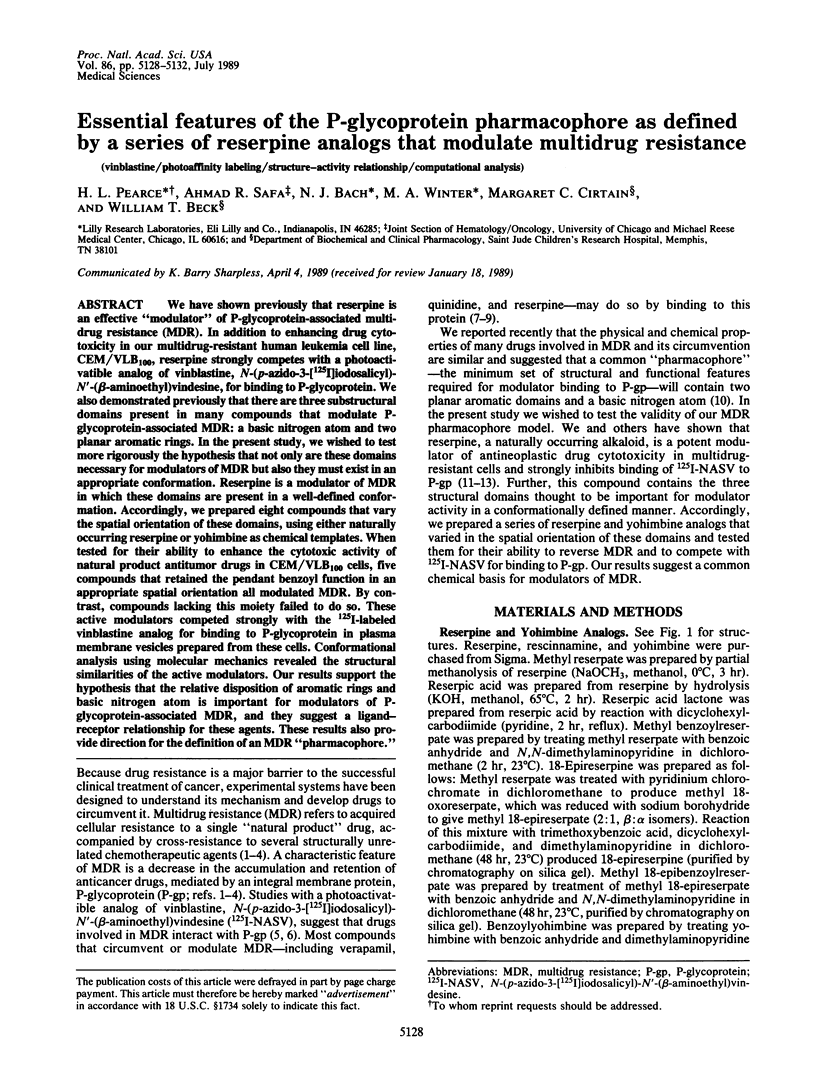Abstract
We have shown previously that reserpine is an effective "modulator" of P-glycoprotein-associated multidrug resistance (MDR). In addition to enhancing drug cytotoxicity in our multidrug-resistant human leukemia cell line, CEM/VLB100, reserpine strongly competes with a photoactivatible analog of vinblastine, N-(p-azido-3-[125I]iodosalicyl)-N'-(beta-aminoethyl)vindesine, for binding to P-glycoprotein. We also demonstrated previously that there are three substructural domains present in many compounds that modulate P-glycoprotein-associated MDR: a basic nitrogen atom and two planar aromatic rings. In the present study, we wished to test more rigorously the hypothesis that not only are these domains necessary for modulators of MDR but also they must exist in an appropriate conformation. Reserpine is a modulator of MDR in which these domains are present in a well-defined conformation. Accordingly, we prepared eight compounds that vary the spatial orientation of these domains, using either naturally occurring reserpine or yohimbine as chemical templates. When tested for their ability to enhance the cytotoxic activity of natural product antitumor drugs in CEM/VLB100 cells, five compounds that retained the pendant benzoyl function in an appropriate spatial orientation all modulated MDR. By contrast, compounds lacking this moiety failed to do so. These active modulators competed strongly with the 125I-labeled vinblastine analog for binding to P-glycoprotein in plasma membrane vesicles prepared from these cells. Conformational analysis using molecular mechanics revealed the structural similarities of the active modulators. Our results support the hypothesis that the relative disposition of aromatic rings and basic nitrogen atom is important for modulators of P-glycoprotein-associated MDR, and they suggest a ligand-receptor relationship for these agents. These results also provide direction for the definition of an MDR "pharmacophore."
Full text
PDF




Images in this article
Selected References
These references are in PubMed. This may not be the complete list of references from this article.
- Akiyama S., Cornwell M. M., Kuwano M., Pastan I., Gottesman M. M. Most drugs that reverse multidrug resistance also inhibit photoaffinity labeling of P-glycoprotein by a vinblastine analog. Mol Pharmacol. 1988 Feb;33(2):144–147. [PubMed] [Google Scholar]
- Beck W. T. Cellular pharmacology of Vinca alkaloid resistance and its circumvention. Adv Enzyme Regul. 1984;22:207–227. doi: 10.1016/0065-2571(84)90015-3. [DOI] [PubMed] [Google Scholar]
- Beck W. T., Cirtain M. C., Danks M. K., Felsted R. L., Safa A. R., Wolverton J. S., Suttle D. P., Trent J. M. Pharmacological, molecular, and cytogenetic analysis of "atypical" multidrug-resistant human leukemic cells. Cancer Res. 1987 Oct 15;47(20):5455–5460. [PubMed] [Google Scholar]
- Beck W. T., Cirtain M. C., Glover C. J., Felsted R. L., Safa A. R. Effects of indole alkaloids on multidrug resistance and labeling of P-glycoprotein by a photoaffinity analog of vinblastine. Biochem Biophys Res Commun. 1988 Jun 30;153(3):959–966. doi: 10.1016/s0006-291x(88)81321-4. [DOI] [PubMed] [Google Scholar]
- Beck W. T., Cirtain M. C., Look A. T., Ashmun R. A. Reversal of Vinca alkaloid resistance but not multiple drug resistance in human leukemic cells by verapamil. Cancer Res. 1986 Feb;46(2):778–784. [PubMed] [Google Scholar]
- Beck W. T., Mueller T. J., Tanzer L. R. Altered surface membrane glycoproteins in Vinca alkaloid-resistant human leukemic lymphoblasts. Cancer Res. 1979 Jun;39(6 Pt 1):2070–2076. [PubMed] [Google Scholar]
- Beck W. T. The cell biology of multiple drug resistance. Biochem Pharmacol. 1987 Sep 15;36(18):2879–2887. doi: 10.1016/0006-2952(87)90198-5. [DOI] [PubMed] [Google Scholar]
- Beck W. T. Vinca alkaloid-resistant phenotype in cultured human leukemic lymphoblasts. Cancer Treat Rep. 1983 Oct;67(10):875–882. [PubMed] [Google Scholar]
- Bradley G., Juranka P. F., Ling V. Mechanism of multidrug resistance. Biochim Biophys Acta. 1988 Aug 3;948(1):87–128. doi: 10.1016/0304-419x(88)90006-6. [DOI] [PubMed] [Google Scholar]
- Cornwell M. M., Pastan I., Gottesman M. M. Certain calcium channel blockers bind specifically to multidrug-resistant human KB carcinoma membrane vesicles and inhibit drug binding to P-glycoprotein. J Biol Chem. 1987 Feb 15;262(5):2166–2170. [PubMed] [Google Scholar]
- Cornwell M. M., Safa A. R., Felsted R. L., Gottesman M. M., Pastan I. Membrane vesicles from multidrug-resistant human cancer cells contain a specific 150- to 170-kDa protein detected by photoaffinity labeling. Proc Natl Acad Sci U S A. 1986 Jun;83(11):3847–3850. doi: 10.1073/pnas.83.11.3847. [DOI] [PMC free article] [PubMed] [Google Scholar]
- Moscow J. A., Cowan K. H. Multidrug resistance. J Natl Cancer Inst. 1988 Mar 2;80(1):14–20. doi: 10.1093/jnci/80.1.14. [DOI] [PubMed] [Google Scholar]
- Pastan I., Gottesman M. Multiple-drug resistance in human cancer. N Engl J Med. 1987 May 28;316(22):1388–1393. doi: 10.1056/NEJM198705283162207. [DOI] [PubMed] [Google Scholar]
- Safa A. R., Glover C. J., Meyers M. B., Biedler J. L., Felsted R. L. Vinblastine photoaffinity labeling of a high molecular weight surface membrane glycoprotein specific for multidrug-resistant cells. J Biol Chem. 1986 May 15;261(14):6137–6140. [PubMed] [Google Scholar]
- Safa A. R., Glover C. J., Sewell J. L., Meyers M. B., Biedler J. L., Felsted R. L. Identification of the multidrug resistance-related membrane glycoprotein as an acceptor for calcium channel blockers. J Biol Chem. 1987 Jun 5;262(16):7884–7888. [PubMed] [Google Scholar]
- Zamora J. M., Pearce H. L., Beck W. T. Physical-chemical properties shared by compounds that modulate multidrug resistance in human leukemic cells. Mol Pharmacol. 1988 Apr;33(4):454–462. [PubMed] [Google Scholar]





